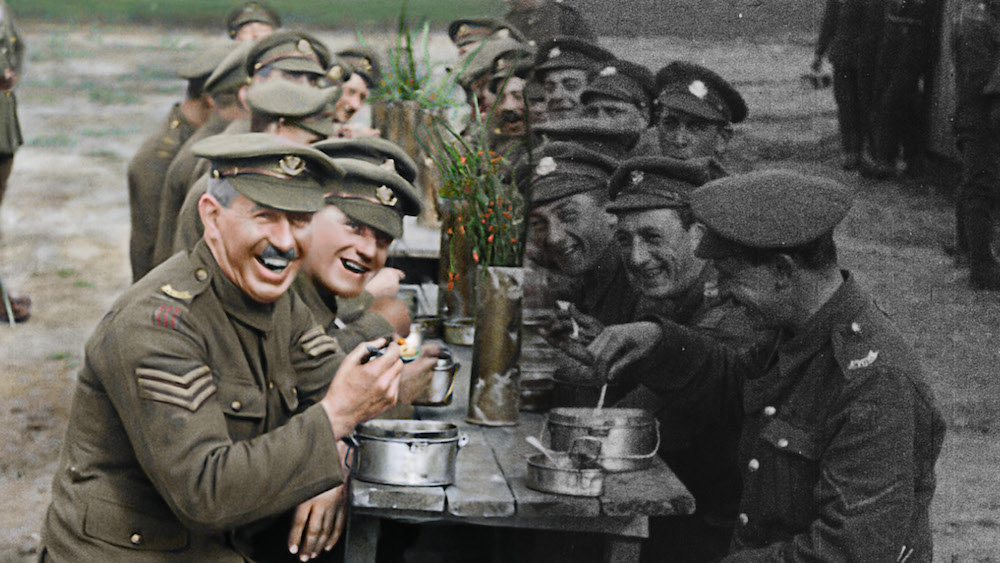London Film Review: Peter Jackson’s ‘They Shall Not Grow Old’
By Guy Lodge
LOS ANGELES (Variety.com) – “Filmed on location on the Western Front, 1914 to 1918” claims the very final credit of “They Shall Not Grow Old,” buried in small print once a veritable army of magic-working technicians’ names has scrolled. It’s a cute throwaway detail that nonetheless defines what’s special about Peter Jackson’s path-breaking First World War documentary, composed as it is entirely from once-murky archive film and audio testimony: So dazzlingly transformative is the restoration of this footage that it may as well be the product of a movie shoot.
Plundering the vast collection of Britain’s Imperial War Museum, Jackson has applied the same digital wizardry that he used to make a reality of Tolkien’s Middle Earth to make a reality of, well, another reality, one on the verge of vanishing: the collective experience of British soldiers on the front, from the gung-ho spirit of enlistment through to the hollowing exhaustion of PTSD. As over 100 battle-scarred survivors narrate proceedings from beyond the grave, a collection of scratched, century-old film once rendered visually inscrutable by wear and tear emerges from the digital chrysalis as pristinely tactile and alive, blown up into grand spectacle via sensitive colorization and 3D conversion.
If this sounds like the world’s most state-of-the-art educational video, that’s exactly what it is. Alongside its U.K. cinema release, a copy of the film — commissioned by the aforementioned museum and 14-18 Now, a British arts program dedicated to the War’s centenary — will be sent to every high school in the U.K., surely answering the prayers of frazzled history teachers everywhere short on compelling visual aids for the far less abundantly illustrated of the two world wars. Yet Jackson, as is his wont, has fashioned his film as a big-screen experience first and foremost: If the idea of watching WWI archival reels in 3D sounds gimmicky on the face of it, it proves to have an experiential purpose, conveying the juddering movement and chaos of a conflict many of us have largely viewed through calcified still images.
In terms of content, “They Shall Never Grow Old” is inevitably less revolutionary. The bones of the Great War have been exhaustively picked over, and Jackson’s interest lies not in uncovering new information, but in adding fresh dimensions of familiarity to what we already know. In addition to a thorough clean-up job, the film’s oral history has been as thoughtfully curated and threaded as the film footage it seamlessly accompanies, adding up to a fluent, first-hand human narrative unencumbered by dates, milestones and political process. This film’s business — the everyday, on-the-ground shifts in soldierly mood and morale across four very long years — is what tends to get left out of classroom textbooks.
And so, in place of any mention of the terms “Triple Entente” or “Treaty of Versailles,” we get vivid, sometimes ruefully funny memories of horse-clipper haircuts, heavy boots softened with urine, and the perils of rats and lice in battle. There are interludes of laddish levity amid grimly wearying scenes of combat, cannon-fire and mine explosions like shattering, brown-on-brown firework displays. In what seems a nod to his old days as a gross-out genre merchant, Jackson also can’t resist punishingly crisp closeups of gangrenous body parts in an angry puce tones; the hell of war has rarely been quite this forensically magnified.
Yet as the film wears on, the talk turns wistfully to death and survival, the cost of war and the questionable point of it all once nominal victory had been declared. “It was one of the flattest moments of my life,” observes one soldier on the Allied triumph; another likens the return from the front to the feeling of being fired from a job. Perhaps surprisingly, with a blockbuster merchant at the helm, little here is rousing or sentimental; the film’s mordant intimacy of perspective endures as stoically as the speakers themselves.
The bells and whistles are all in the technique, though Jackson takes time to show his hand. The first 20-odd minutes of the film depict preparations for war in boxy-framed black and white, niftily but hardly mind-blowingly enhanced by the 3D treatment. The coup de théâtre comes once we hit the trenches, as the frame expands, the monochrome palette blushes in shades of earth and military green, and suddenly, in a transition oddly akin to the iridescent lightbulb moment in “The Wizard of Oz,” this truly is the war as we’ve never seen it before. Years after the gratuitous exertions of his “Hobbit” trilogy, Jackson has found fresh, humane purpose to his ambitious technical artistry, opening up any number of exciting, slightly terrifying possibilities in the realm of archival documentary.
But if “They Shall Not Grow Old” is head-spinning for its jolting animation of creakily shot battle scenes — tricked out with ingeniously integrated sound editing and seamlessly retimed from 13 frames a second to 24 — its greatest revelation isn’t one of sound and fury. Rather, it’s the film’s faces that stick longest in the mind. Through the exhaustive transformation completed by Jackson’s team, visages that were all but indistinguishably blurred in the archives take on shape, character and creases of worry, terror and occasional hilarity. In conjunction with the film’s intricately stitched narration, its soldiers turn from cold statistics to warm, quivering human beings, drawing us with renewed empathy into a Great War that, they all but unanimously agree, had precious little greatness to it.

